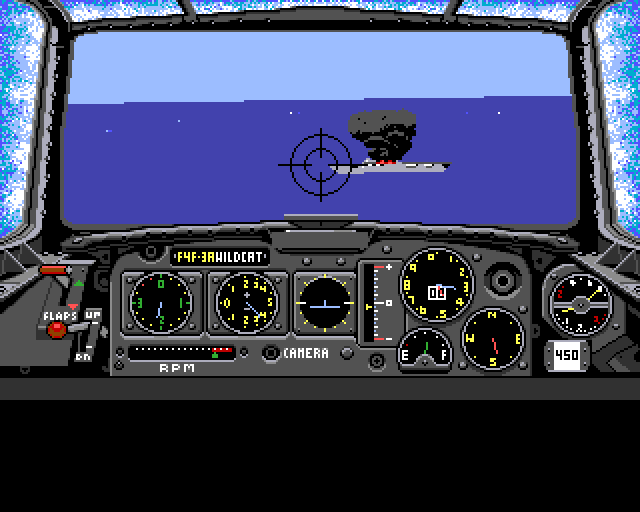Retro Replay Review
Gameplay
Battlehawks 1942 drops you into the cockpit of a WWII fighter, offering you the choice to fly as an American or Japanese pilot across four distinct operations in the Pacific Theatre. Each operation presents unique mission objectives—ranging from bomber escorts and aerial dogfights to anti-ship strikes and reconnaissance runs. The depth of simulation is immediate: you must manage fuel, ammo, and engine heat while keeping an eye on wingmen and enemy formations. Despite its vintage roots, the game’s control scheme balances realism and accessibility, allowing newcomers to dip toes into flight sims without overwhelming complexity.
The manual that accompanies Battlehawks 1942 reads almost like a mini history book, featuring detailed write-ups on each aircraft, its weapon loadouts, and the tactical doctrines employed by both sides. With twelve aircraft (and their variants) to master—everything from nimble Zero fighters to heavily armed Wildcats—players can tailor their experience by choosing the plane best suited to each mission. The inclusion of roughly 20 ship types adds another layer of strategy: torpedo runs against destroyers feel weighty, while strafing runs against subs require pinpoint accuracy.
The mission structure is non-linear, giving you the freedom to attempt objectives in multiple ways. You can stick close to the deck for surprise attacks, climb high for interception duties, or coordinate with AI wingmen to establish an aerial blockade. The learning curve is noticeable, but the in-game briefing screens and the historically rich manual work in tandem to ease players into the complexities of carrier-based warfare. Veteran sim enthusiasts will appreciate the fine control over throttle, flaps, and armaments, while history buffs will relish the educational insights woven into each sortie.
Graphics
For a late-1980s release, Battlehawks 1942 delivers surprisingly crisp visuals that stand up well compared to its contemporaries. The cockpit view is rendered with clear instrument panels, allowing you to read altimeter and airspeed gauges at a glance. External views provide basic but recognizable silhouettes of aircraft, ships, and islands. While polygon counts are modest by modern standards, thoughtful shading and color choices convey the Pacific’s bright blue skies and sun-bleached atolls effectively.
Sea and sky blend with subtle horizon fades, giving a genuine sense of altitude. Sun glint on the ocean surface lends an extra layer of immersion when you’re lining up a torpedo or strafing run. Explosions and smoke trails, though simple, are satisfyingly loud and visible, adding drama to every engagement. Ship models, while blocky, are distinguishable as carriers, battleships, or destroyers—an important feature when you need to pick high-value targets amidst a heated dogfight.
Performance remains stable even during large fleet encounters, and the game’s palette limits don’t detract from its clarity. The visual design is pragmatic: every cockpit gauge, radar blip, and ship outline serves a gameplay purpose. In an era where many sims prioritized realism at the expense of readability, Battlehawks 1942 strikes a balance that keeps the action both authentic and comprehensible.
Story
Rather than a cinematic narrative, Battlehawks 1942 unfolds through mission briefings and debriefings, enriched by the game’s comprehensive manual. Each operation corresponds to a real historical engagement—Midway, Coral Sea, Wake Island, or the Solomons campaign—and your goals reflect the strategic priorities of the period. Briefing screens include maps, unit dispositions, and suggested tactics, grounding each sortie in a genuine WWII context.
The manual is more than just a reference: it reads like an immersive dossier, complete with historical timelines, aircraft specifications, and personal accounts from veteran pilots. Flicking through its pages before a mission feels like preparing for a lecture on Pacific air warfare. This educational slant deepens your connection to every dogfight and bombing run, turning routine missions into vignettes of personal courage and tactical ingenuity.
While there’s no branching storyline in the modern sense, the choice to fly for either side and the variable outcomes of each mission give a sense of agency and replayability. Completing objectives as the Japanese fleet commander offers a starkly different perspective than flying for the U.S. Navy. By alternating viewpoints, players gain a rounded understanding of the Pacific conflict, making each campaign feel like a chapter in a larger historical epic.
Overall Experience
Battlehawks 1942 remains a compelling experience for anyone intrigued by WWII aviation or the art of flight simulation. Its blend of real-time air combat, methodical mission planning, and richly detailed manual creates a cohesive package that educates as much as it entertains. The four campaigns ensure that you’re never repeating the same mission, and the wide array of aircraft and ship classes keeps tactics fresh across dozens of sorties.
The game’s dated visuals and user interface may challenge today’s gamers, but the depth of its simulation, combined with the manual’s trove of historical data, provides a sense of authenticity few modern titles can match. Mastering throttle management, gunnery solutions, and squadron coordination rewards patience and attention to detail, while the feeling of unleashing a well-timed volley of rockets on an enemy carrier remains thrilling decades later.
Ultimately, Battlehawks 1942 stands as a landmark title in the Lucasfilm/Lawrence Holland trilogy, offering both entertainment and education. Whether you’re a hardened sim pilot looking for a classic challenge or a history enthusiast eager to experience the Pacific Theatre through a pilot’s eyes, this game delivers an absorbing journey into the skies of WWII.
 Retro Replay Retro Replay gaming reviews, news, emulation, geek stuff and more!
Retro Replay Retro Replay gaming reviews, news, emulation, geek stuff and more!









Reviews
There are no reviews yet.